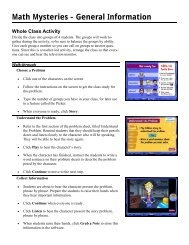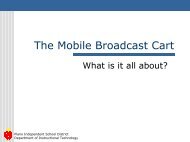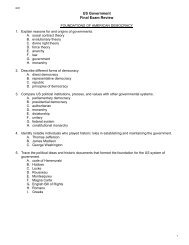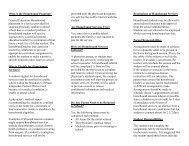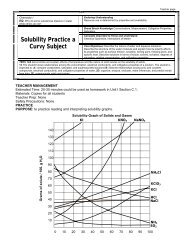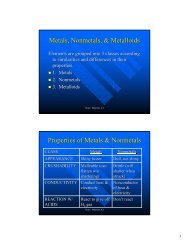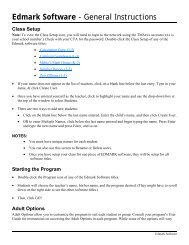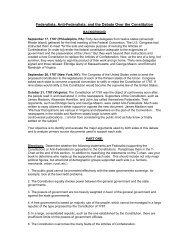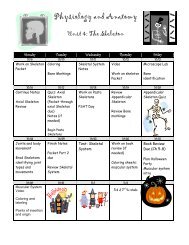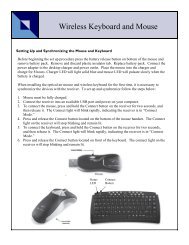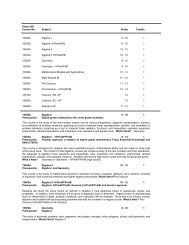Border Gate Protocol
Border Gate Protocol
Border Gate Protocol
You also want an ePaper? Increase the reach of your titles
YUMPU automatically turns print PDFs into web optimized ePapers that Google loves.
Unit 5: Intradomain and Interdomain Routing <strong>Protocol</strong>s<br />
Lesson 5-3: <strong>Border</strong> <strong>Gate</strong>way <strong>Protocol</strong><br />
At a Glance<br />
The <strong>Border</strong> <strong>Gate</strong>way <strong>Protocol</strong> (BGP) is an interdomain routing protocol<br />
used in TCP/IP internetworks. BGP was created to allow organizations,<br />
with large networks, to control how those networks are used. This is<br />
particularly important to networks that sell transit service to others.<br />
What You Will Learn<br />
After completing this lesson, you will be able to do the following:<br />
• Describe the <strong>Border</strong> <strong>Gate</strong>way <strong>Protocol</strong>.<br />
• Diagram a BGP internetwork.<br />
• Identify the differences between inter-autonomous routing, intraautonomous<br />
routing, and pass-through routing.<br />
• Compare BGP and RIP.<br />
ST0025804A 225
Lesson 5-3: <strong>Border</strong> <strong>Gate</strong>way <strong>Protocol</strong><br />
.<br />
Tech Talk<br />
• Autonomous System (AS)—A network controlled by a single set of<br />
policies, for example, the Internet.<br />
• Distance Path Routing—An algorithm used by BGP where each AS<br />
adds its ID to every route that it advertises to its neighbors.<br />
• Intra-autonomous Routing—BGP routing that occurs within the same<br />
autonomous system.<br />
• Inter-autonomous Routing—BGP routing that occurs between two or<br />
more different autonomous systems.<br />
• Pass-through Routing—BGP routing that occurs when a router passes<br />
a packet, that did not originate in its own system and is not destined to<br />
its system, on to another autonomous system.<br />
<strong>Border</strong> <strong>Gate</strong>way <strong>Protocol</strong><br />
The <strong>Border</strong> <strong>Gate</strong>way <strong>Protocol</strong>, BGP, was designed for a purpose different<br />
from the other routing protocols discussed in this unit. The other protocols<br />
were designed on the assumption that a group of routers would cooperate<br />
to provide the best possible service to each packet they encounter. BGP<br />
was designed with nearly the opposite assumption: that the different nodes<br />
have different and possibly competing purposes.<br />
The original Internet was composed of a single, neutral, government<br />
operated backbone, connecting many individual networks. This backbone<br />
appeared politically neutral to the organizations using it. As the Internet,<br />
it became impossible to continue with only a single backbone. In addition,<br />
the wide variety of goals among the organizations involved in the Internet<br />
has made the concept of "neutral" obsolete.<br />
These changes in the political structure of the Internet forced the<br />
development of a routing protocol that could cope with them.<br />
226<br />
ST0025804A<br />
Routing
Unit 5: Intradomain and Interdomain Routing <strong>Protocol</strong>s<br />
Autonomous Systems<br />
Like other routing protocols, BGP relays information between routers. On<br />
the other hand it actually routes traffic between much larger entities called<br />
Autonomous Systems. An Autonomous System, or AS, is a network<br />
controlled by a single set of policies. Examples of an Autonomous System<br />
might be the private, Internet connected network of a large company, or<br />
the section of the Internet backbone operated by another company. BGP<br />
allows these networks to implement policies such as:<br />
• Traffic from Taiwan may not, under any conditions, use the Chinese<br />
national network for transit.<br />
• Traffic from the CIA to the Pentagon must never cross the public<br />
Internet, although any other traffic may do so.<br />
Autonomous Systems<br />
Router<br />
Router<br />
Internet<br />
AS4<br />
Router<br />
Router<br />
Router<br />
Router<br />
<strong>Border</strong><br />
Router<br />
<strong>Border</strong><br />
Router<br />
<strong>Border</strong><br />
Router<br />
<strong>Border</strong><br />
Router<br />
AS1<br />
<strong>Border</strong><br />
Router<br />
<strong>Border</strong><br />
Router<br />
<strong>Border</strong><br />
Router<br />
<strong>Border</strong><br />
Router<br />
<strong>Border</strong><br />
Router<br />
<strong>Border</strong><br />
Router<br />
Router<br />
Router<br />
Router<br />
AS2<br />
Router<br />
Router<br />
AS3<br />
Router<br />
The illustration above shows a possible network with four ASs. It is not<br />
necessary to run BGP on all routers within a network. Since BGP is<br />
responsible only for routing between ASs, it is only necessary to run it on<br />
border routers.<br />
BGP uses TCP for transport. TCP assures BGP of connection-oriented,<br />
error free, multi-hop connectivity between BGP routers.<br />
ST0025804A 227
Lesson 5-3: <strong>Border</strong> <strong>Gate</strong>way <strong>Protocol</strong><br />
Another requirement for BGP is that every BGP router within an AS must<br />
maintain a session with every other BGP router. This is an unfortunate<br />
requirement, since it means that each router must maintain a number of<br />
connections that grows arithmetically with the number of border routers in<br />
the AS. The requirement is necessary to assure that every border router<br />
presents exactly the same view of its AS to the world as every other border<br />
router in the AS. This allows BGP to treat AS's as single "hops" ignoring<br />
their internal policies.<br />
Check Your Understanding<br />
♦ The World Wide Web is an example of hundreds of autonomous<br />
systems linked together into a large internetwork. If the WWW<br />
used the Routing Information <strong>Protocol</strong> (RIP) instead of BGP, what<br />
do you think would be the result?<br />
BGP Mechanism<br />
BGP is a distance-vector protocol that allows the router to transmit the<br />
path between autonomous systems from the source to the destination. It<br />
does not use cost as a metric to calculate the best path; rather it uses a<br />
path ranking system to calculate the best path. The ranking system is an<br />
arbitrary metric established by the network administrator. The network<br />
administrator may use any of many criteria, including AS counts (similar<br />
to hop counts), speed and delays.<br />
BGP routers may be used within autonomous systems, and in between<br />
autonomous systems. BGP routers may also operate as a pass-through<br />
system.<br />
Within inter-autonomous systems, routing occurs between two or more<br />
routers in different autonomous systems. The routers must reside on the<br />
same physical network and maintain constant updates of the entire<br />
internetwork topology. The Internet is an example of BGP operating in an<br />
inter-autonomous system.<br />
228<br />
ST0025804A<br />
Routing
Unit 5: Intradomain and Interdomain Routing <strong>Protocol</strong>s<br />
BGP routers located within the same autonomous system maintain<br />
updates on the system topology. BGP also is used by the routers to<br />
determine which router will function as the border router. Within the<br />
Internet, there are hundreds of intra-autonomous systems using BGP.<br />
When a BGP router receives a packet that did not originate from its<br />
system and is addressed to a destination also not within its autonomous<br />
system, it merely passes the packet through its own system to the next<br />
autonomous system. This is sometimes referred to as pass-through routing.<br />
Routing Tables are Exchanged Between Systems<br />
AS1<br />
<strong>Border</strong> Router<br />
Routing<br />
Table<br />
Internet<br />
Exchange<br />
AS2<br />
<strong>Border</strong> Router<br />
Routing<br />
Table<br />
When there is a change in a routing table, the router sends an update of<br />
only the portion that has changed. The router also only sends information<br />
indicating the best path to a network. BGP routers do not send updates at<br />
regular intervals as do RIP routers.<br />
Distance Path Routing<br />
BGP uses an extension of a distance-vector protocol, called distance-path<br />
routing. Using this algorithm, each AS adds its ID to every route that it<br />
advertises to its neighbors. This makes it easy to identify the shortest<br />
path to another AS since it is simply the route with the fewest ID's<br />
attached. It also makes it easy to eliminate routing loops. If an AS<br />
receives an advertisement with an AS path which already contains its own<br />
ID; it simply discards it, since it has obviously seen it before.<br />
This same mechanism solves the "counting to infinity" problem.<br />
If the link between AS1 and AS2 fails, AS1 will hear the advertisement for<br />
AS1 from AS3. The AS Path on that advertisement, however, will contain<br />
AS's 1, 2, and 3. Since AS2 has obviously heard the advertisement before,<br />
it discards it, and never starts counting to infinity.<br />
ST0025804A 229
Lesson 5-3: <strong>Border</strong> <strong>Gate</strong>way <strong>Protocol</strong><br />
Try It Out<br />
Policy Routing<br />
BGP was created to allow organizations with large networks, to control<br />
how those networks are used. This is a hot topic in the Internet today.<br />
This is particularly important to networks that sell transit service to<br />
others. Most backbone administrators use a policy descriptively called "Hot<br />
Potato Routing". As the name suggests, this means that they get packets<br />
off their own networks as quickly as possible, to minimize the amount of<br />
traffic they carry for other providers.<br />
Materials Needed:<br />
• Windows 95 PC<br />
• Internet Connection<br />
• Any Word Processor (e.g., MS Word)<br />
• Poster Paper<br />
• Pen/Pencil and Paper<br />
1. Research two network practices using routing policies.<br />
2. Use the Internet and any other sources you can find.<br />
3. Create a classroom poster that demonstrates how the two practices use<br />
routing policies to control how a network is used.<br />
4. In class discussion, explain the concepts behind your poster.<br />
Rubric: Suggested Evaluation Criteria and Weightings<br />
Criteria % Your Score<br />
Concise research of two routing policy practices 25<br />
Analysis and synthesis of information 50<br />
Thoughtful Poster and insightful class discussion 25<br />
TOTAL 100<br />
230<br />
ST0025804A<br />
Routing
Unit 5: Intradomain and Interdomain Routing <strong>Protocol</strong>s<br />
Stretch Yourself<br />
Internet Multicast Routing <strong>Protocol</strong>s<br />
The protocols discussed in this unit have all dealt with the delivery of a<br />
packet from a single source to a single destination using unicast or<br />
broadcast techniques.<br />
Internet multicast routing protocols have been developed to allow IP<br />
packets to be sent from one or multiple sources and delivered to multiple<br />
destinations. These protocols are able to overcome the limitations of RIP,<br />
OSPF, and BGP, and support the greater requirements of today’s new<br />
applications.<br />
There are several protocols that fall in the category of Internet multicast<br />
routing:<br />
• Internet Group Membership <strong>Protocol</strong><br />
• <strong>Protocol</strong>-Independent Multicast<br />
• Distance-Vector Multicast Routing <strong>Protocol</strong><br />
• Multicast Open Shortest Path First<br />
Materials Needed:<br />
• Windows 95 PC<br />
• Internet Connection (optional)<br />
• Any Word Processor (e.g., MS Word)<br />
• Pen/Pencil and Paper<br />
Research these protocols and write a brief paper on the mechanisms used<br />
by each protocol. Compare these protocols to the protocols discussed in<br />
this unit. Include in your paper, no less than eight resources.<br />
Rubric: Suggested Evaluation Criteria and Weightings<br />
Criteria % Your Score<br />
Analysis and synthesis of information 50<br />
Quality paper comparing protocols 40<br />
Minimum of eight resources 10<br />
TOTAL 100<br />
ST0025804A 231
Lesson 5-3: <strong>Border</strong> <strong>Gate</strong>way <strong>Protocol</strong><br />
Network Wizards<br />
Visit Your Local ISP<br />
Internet Service Providers are the organizations that provide individuals a<br />
link to the WWW and the Internet via a cable or phone modem.<br />
Individuals are charged for the right to connect to the WWW through their<br />
ISP. Additionally, ISPs often will host web sites created by their clients for<br />
another fee. In fact, for each additional service, the ISP usually adds more<br />
fees.<br />
With such a large profitable network as the Internet and the WWW, it<br />
would be interesting to discover how the whole concept is funded.<br />
Materials Needed:<br />
• Local ISP available for interview<br />
• Windows 95 PC<br />
• Any Word Processor (e.g., MS Word)<br />
• Any Spreadsheet Program (e.g., MS Excel)<br />
• Pen/Pencil and Paper<br />
• Color Pencils or Color Markers<br />
1. Make an appointment to interview the manager of your local ISP.<br />
2. Before your interview, make up a commercial company that sells a<br />
product in which you have a special interest. Your company wants to<br />
have a web site to advertise your product to the greatest number of<br />
buyers.<br />
3. Write up a description of your company and the product(s) that it sells.<br />
4. Draw a detailed illustration of your web site, including special features<br />
that the site has to offer (Java applets, video, sound, and CGI scripts).<br />
Your goal is to outline how your local ISP structures their rates to their<br />
customers and what fees the ISP must pay and to whom. Make sure<br />
you get the fees for special services such as web site hosting, including<br />
fees for special features you desire in your web site.<br />
5. Create a spreadsheet using your ISP’s rate structure and determine<br />
from the spreadsheet what your web site will cost to operate per month.<br />
Follow up your interview with a thank you note.<br />
232<br />
ST0025804A<br />
Routing
Unit 5: Intradomain and Interdomain Routing <strong>Protocol</strong>s<br />
Rubric: Suggested Evaluation Criteria and Weightings<br />
Criteria % Your Score<br />
Thorough description of the student’s company 20<br />
Detailed illustration of the web site suitable for<br />
reproduction<br />
Accurate spreadsheet and analysis of the cost of<br />
the company’s web site<br />
40<br />
40<br />
TOTAL 100<br />
Summary<br />
In this unit, you learned the following:<br />
• The <strong>Border</strong> <strong>Gate</strong>way <strong>Protocol</strong>.<br />
• How to diagram a BGP internetwork.<br />
• The differences between inter-autonomous routing, intra-autonomous<br />
routing, and pass-through routing.<br />
• The comparison between BGP and RIP.<br />
ST0025804A 233
Lesson 5-3: <strong>Border</strong> <strong>Gate</strong>way <strong>Protocol</strong><br />
Review Questions<br />
Name_______________<br />
Lesson 5-3: <strong>Border</strong> <strong>Gate</strong>way <strong>Protocol</strong><br />
Part A<br />
1. Describe the <strong>Border</strong> <strong>Gate</strong>way <strong>Protocol</strong> and identify what types of<br />
networks use this protocol.<br />
Part B<br />
1. Diagram a BGP internetwork, including labels.<br />
Part C<br />
Define each of the terms.<br />
Terms<br />
1. Inter-autonomous<br />
Routing<br />
Definitions<br />
2. Intra-autonomous<br />
Routing<br />
3. Pass –Through Routing<br />
234<br />
ST0025804A<br />
Routing
Unit 5: Intradomain and Interdomain Routing <strong>Protocol</strong>s<br />
Part D<br />
1. Compare the <strong>Border</strong> <strong>Gate</strong>way and Routing Information <strong>Protocol</strong>s.<br />
Scoring<br />
Rubric: Suggested Evaluation Criteria and Weightings<br />
Criteria % Your Score<br />
Part A: Describe the <strong>Border</strong> <strong>Gate</strong>way <strong>Protocol</strong> 30<br />
Part B: Diagram a BGP internetwork 25<br />
Part C: Identify the differences between interautonomous<br />
routing, intra-autonomous<br />
routing, and pass-through routing<br />
20<br />
Part D: Compare BGP and RIP 25<br />
TOTAL 100<br />
Try It Out 100<br />
Stretch Yourself 100<br />
Network Wizards 100<br />
FINAL TOTAL 400<br />
ST0025804A 235
Lesson 5-3: <strong>Border</strong> <strong>Gate</strong>way <strong>Protocol</strong><br />
Resources<br />
Comer, D. E. (1995). Internetworking With TCP/IP : Principles, <strong>Protocol</strong>s,<br />
and Architecture 3rd edition, Prentice Hall, Upper Saddle River, New<br />
Jersey.<br />
Perlman, R. (1992). Interconnections: Bridges and Routers, Addison-<br />
Wesley Publishing Co.,Reading, MA.<br />
Stevens, W. R.(1994). TCP/IP Illustrated, Volume 1: The <strong>Protocol</strong>s,<br />
Addison-Wesley Publishing Co., Reading, MA.<br />
Tannenbaum, A.S. (1996). Computer Networks, Prentice Hall, Upper<br />
Saddle River, New Jersey.<br />
236<br />
ST0025804A<br />
Routing




